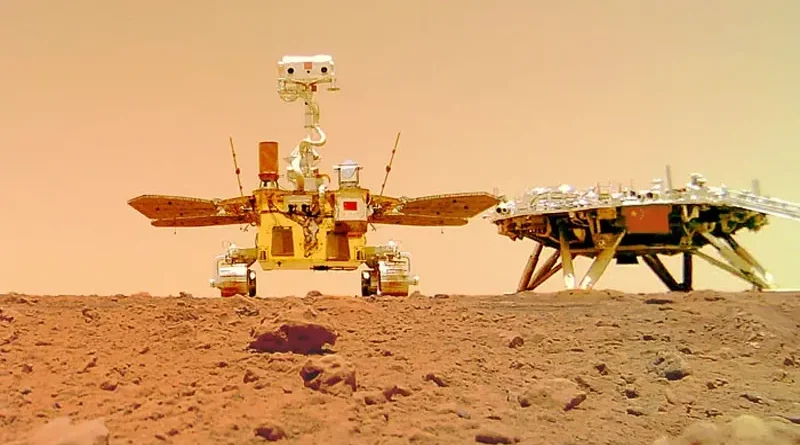China’s Zhurong rover discovers signs of water on Mars
Scientists have estimated that water may have been present on Mars after observing salt-rich dunes with cracks, with the help of China’s Zhurong rover, reported ABC News.
According to the findings, the presence of water may have been widespread and very recent. The observations also help conclude potentially fertile areas in the hot regions of Mars and that suitable conditions may have existed for life on the planet, however, further study into the matter is required.
The mission leaders said that the Zhurong rover went into hibernation a year ago for Martian winter and has yet to come out.
A picture of Chinas Mars rover and the landing platform on Mars. A tiny picture of the 2022 Winter Games mascots is shown next to the Chinese national flag on the front of the landing platform. — China National Space Administration/File
A picture of China’s Mars rover and the landing platform on Mars. A tiny picture of the 2022 Winter Games mascots is shown next to the Chinese national flag on the front of the landing platform. — China National Space Administration/File
Zhang Rongqiao, the mission’s chief designer, said that “its solar panels are likely covered with dust, choking off its power source and possibly preventing the rover from operating again.”
As Zhurong was hybernated, it collected information about salt-rich dunes with cracks and crusts. According to researchers, it was likely mixed with melting morning frost or snow as recently as a few hundred thousand years ago.
This picture released on May 19, 2021, by the China National Space Administration (CNSA) shows an image taken by the front obstacle avoidance camera of Chinas Zhurong rover, facing the rovers direction of movement and showing the deployment of the ramp mechanism, on the surface of Mars, after it landed on Mars on May 15, 2021. — AFP
This picture released on May 19, 2021, by the China National Space Administration (CNSA) shows an image taken by the front obstacle avoidance camera of China’s Zhurong rover, facing the rover’s direction of movement and showing the deployment of the ramp mechanism, on the surface of Mars, after it landed on Mars on May 15, 2021. — AFP
Scientists have estimated that the cracks and other dune features formed in Mars’ Utopia Planitia — a vast plain in the northern hemisphere — in sometime between 1.4 million to 400,000 years ago or even younger.
They opined that Mars’ conditions may have been similar to that of now — with rivers and lakes dried up and no longer flowing as they did billions of years earlier.
The Beijing-based team wrote, in a study published in Science Advances, that studying the structure and chemical makeup of these dunes can provide insights into the possibility of water activity during this period.
“We think it could be a small amount … no more than a film of water on the surface,” co-author Xiaoguang Qin of the Institute of Geology and Geophysics told ABC.
The water was not directly detected by the Chinese rover in the form of frost or ice. However, computer simulations and observations by other spacecraft at Mars indicate that even nowadays at certain times of the year, conditions could be suitable for the water to appear, Qin said.
Planetary, scientist Frederic Schmidt at the University of Paris-Saclay, who was not involved in the study, said: What’s notable about the study is how young the dunes are.
“This is clearly a new piece of science for this region,” he told ABC.
The Chinese scientists said small pockets of water from thawing frost or snow, mixed with salt, likely resulted in the small cracks, hard crusty surfaces, loose particles and other dune features like depressions and ridges.
According to them, the wind is not the cause, as well as frost is made of carbon dioxide, which makes up the bulk of Mars’ atmosphere.
China’s Zhurong — a six-wheeled rover named after a fire god in Chinese mythology — was launched in 2020. It arrived on Mars in 2021 and spent a year wandering the red planet before it went into hibernation last May.
The rover had functioned more than it was expected travelling more than a mile (1,921 meters).

